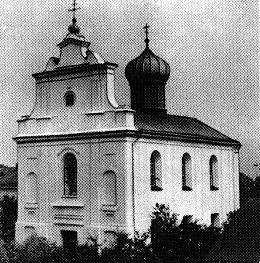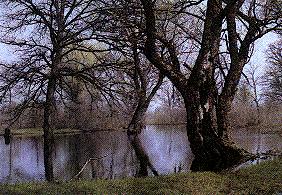![]()

Pinsk is the centre of the Pinsk district, Brest region, situated at the
confluence of the Pina and Prypiac' rivers, 175 km East of Brest, a station on the railway
line Brest-Luniniec, a highway junction and river port.
Population: 130,000 (1995)

The historical "Pinesk" was first mentioned in the chronicles of 1097 and is thus one of the oldest Slavic settlements. The name is derived from the river Pina. Pinsk's early history is closely linked with the history of another Belarusan city - Turau. Until the mid-12th century Pinsk was part of the Turau principality. Later, in the 13th century, it became the centre of a principality of its own.
The Pinsk principality had an important strategic location, between the principalities
of Novaharodak (see also Navahradak) and Galic-Valyn', which
fought each other for the right to unite the other Slavic territories. Pinsk did not take
part in this struggle, although it was inclined towards the princes of Novaharodak, which
is shown by the fact that the future prince of Novaharodak and future Great Duke of Litva
Vojsalk spent some time in Pinsk. 
In 1320 Pinsk became part of the Grand Duchy of Litva (Lithuania) (see also The origins of the Grand Duchy of Litva) From this time on Pinsk was ruled by the son of the Grand Duke Gedymin, Narymunt. Afterwards, for the next two centuries the city had different rulers. In 1581 Pinsk was granted the Magdeburg Code of Law.
From 1633 on Pinsk had a secondary school, a so-called brotherhood school (the brotherhoods were religious citizens' organisations with the aim of providing education for their members and their children).
In 1648, on the eve of the war with Muscovite Russia, Pinsk was occupied by Ukrainian
Cossack army under commander Niababy and could only be reconquered with great difficulty
by prince Janus Radzivil, a high-ranking commander in the GDL army. During the war between
Moscow and the GDL (1654-1667) the city suffered heavily from the attacks of the Muscovite
army under its commander Valkonski and its allied army of Ukrainian Cossacks. On the 5th
October 1655 Pinsk was occupied. The conquerors ravaged the city and its surroundings,
tortured and killed many of its inhabitants. The chronicles describe how the wounded were
buried alive and houses set on fire. The churches were especially badly plundered. All the
gold, bells and icons were stolen, the churches - both Orthodox and Catholic - were burnt,
often even the priests were killed. Thus the Muscovite Tsar Alexej, who wanted to be the
only ruler of all Eastern Slavic peoples, took revenge on the GDL, and the Muscovite
Orthodox Church had an opportunity to assert itself as the only successor of
Constantinople, which had been taken by the Turks in 1453. Leaving Pinsk, the troops set
it on fire, and both the city and the castle were completely destroyed. 
Tragically, even today every Russian pupil (and now also Belarusan again !!!) learns at school that this war - just like many other wars with Russia - were fought "for the liberation of our Belarusan brothers". In reality Muscovite Russia was pursuing its usual policy of conquest, whereby not only the culture, but all national particularities of the Belarusans were meant to be systematically destroyed, so that it would afterwards be easier to declare them part of the "single Russian people".
In 1706 Pinsk was again ravaged, this time by the army of the Swedish king Charles XII. In spite of all the wars the city recovered. This recovery manifested itself, for example, in the existence of a printing workshop in Pinsk from 1729-44.
In 1793 Pinsk became part of the Russian Empire.
In 1898 Golda Meir, future prime minister of Israel(1969-1974), was born in Pinsk. In her
memoirs she remembers the city of her childhood. Jews accounted for a large part of the
population of Belarusan cities. In contrast to other European countries - such as Spain,
Germany, Poland and Russia - the GDL was relatively tolerant with regard to Jews. By the
beginning of the 20th century 14 per cent of the total population in Belarus were Jews.
From 1921 to 1939 Pinsk was part of Poland, from 1939 onwards part of the BSSR.

Today Pinsk is a city in the South of Belarus', it has a river port and is linked
through the Dniepr-Bug canal (built 1775-1848) with the Bug river and, through the Wisla
river with the Baltic Sea. Another canal, the "Great Pinsk Canal" or
"Ahinski canal", was built from 1765-75 at the expense of Mihal Kazimir Ahinski,
a high-ranking commander in the GDL army; and linked the Jasielda river, the Northern
tributary of the Prypiac', with the Scara, a tributary of the Nioman. This canal was
damaged in both World Wars and is in a poor state today, although it could be restored as
a historical monument.
Some of Pinsk's monuments of architecture have remained to the present day. They are a
testimony of the city's former significance. Examples are the Catholic church and
Franciscan monastery, which dates to the 16th-18th century and was rebuilt in 1920, the
Jesuit college, rebuilt in 1651-75 (the college church had been ravaged in the 1950s), the
Catholic church of Karl Barmeus (1770-82), St.Barbara's Church (1786) and the Pinsk palace
(1784-94). Several 19th-century and early-20th-century buildings are still standing. 
This article about Pinsk would not be complete without a mention of the population of that area. Many of the people living in South-Eastern Belarus, from Kamianec in the West to Mazyr in the East, call themselves "palieshuki" (pronounced paleshu'ki), thus identifying themselves with the area where they live - Paliessie, a low marshland along the rivers Prypiac' and Bug and their Southern tributaries. The people from the immediate surroundings of Pinsk call themselves "pinchuki" (pronounced pinchu'ki), The dialect spoken in this area differs from both Belarusan and Ukrainian, it has loan-words from both languages and also its own specific words and expressions which can only be found there. The specific accent of the "palieshuki" distinguishes them from other Belarusians and from Ukrainians as well. In recent times people have tried to link this Western-Paliessie ethno-political phenomenon with the name of a Baltic tribe - the Jacviahi - which lived in parts of the Paliessie until the 13th/14th century and was then assimilated by the Belarusians. But this is a controversial theory and is far from universally supported. Nevertheless one must not overlook the originality of the culture of that region and the fact that a significant proportion of the population regard the local dialect as their mother tongue.
This page is part of the Virtual Guide to Belarus - a collaborative project of Belarusian scientists abroad Go to Belarusian towns, cities and several villages - Go to Belarusian Heritage main page © 1995-2004 VG |
 |